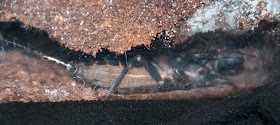
We are very sorry to say, our off-exhibit vinegaroon passed away this past weekend. Adrian found her Sunday morning. Typical of her easy to care for nature, she was up on top of the soil, so that we didn’t have to dig around for her.

Theoretically, an Animal Caretaker doesn’t have favorites, but likes all the animals equally. In reality, there are exceptions, and Vinnea was one of them. She was an industrious little arthropod who won our love by her methodical, even obsessive digging and tunneling. When she appeared to be gravid, we were like a whole team of aunts and uncles, rooting for her to give us little “mini-garoons” to dote on. And when it became clear that she was suffering from ill health, we all wanted to find the magic bullet that would help this mysterious little animal to get well.
Unfortunately, not much is known about vinegaroon husbandry. We are pretty good at keeping them alive and happy, but not so much with the big life transitions – reproduction, shedding, and death. I believe she had shed her final skin already when we got her, but I will always be sorry she didn’t get to have those babies, if there were any.

Vinnea spent her declining years in the home she excavated for herself, or making periodic visits to the surface to look for crickets and water. She never knew cold, predation, or drought. She had dark places to go, and lighted areas to give her a circadian rhythm. I believe we did whatever was possible to make her happy.
She will be missed.















